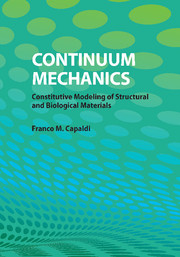8 - Continuum Mixture Theory
Published online by Cambridge University Press: 05 August 2012
Summary
When discussing the development of constitutive models for the ideal gas, fluids, and elastic solids, we had restricted the discussion to materials that consist of a single phase. However, there are many applications where a single material model may be used to represent the behavior of multiple interacting phases. For example, consider biological tissue, which we may think of as being made up of a solid component that consists of the extracellular matrix, a fluid component that contains significant quantities of water and smaller amounts of charged particles, and living cells that secrete substances and react to chemical and mechanical stimuli. In addition, cells undergo growth or death and cause remodeling of the extracellular matrix in response to external stimuli. It is the interaction among all of these phenomena over time that gives biological materials such a diverse and interesting response.
Using continuum mixture theory, we can model the extracellular matrix and the permeating fluid with a single model. This model consists of two continuously distributed phases that interact with one another through the transfer of momentum and energy. In reality, the solid phase and the fluid phase cannot occupy the same region of space. The true microstructure of the material may consist of an extracellular network with channels through which fluid is transported, but the model treats both phases as coexisting at the same spatial points (Figure 8.1). The continuum multiphase model performs well at capturing the aggregate behavior for many materials when the alternative, which is to model the detailed microscopic structure and phase interactions directly, is computationally intractable.
- Type
- Chapter
- Information
- Continuum MechanicsConstitutive Modeling of Structural and Biological Materials, pp. 214 - 243Publisher: Cambridge University PressPrint publication year: 2012



